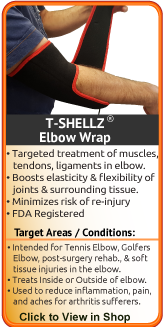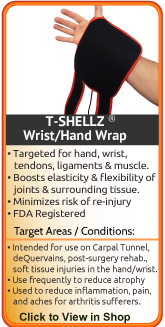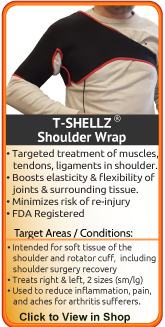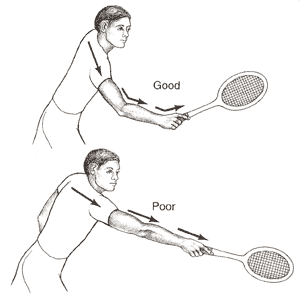How To Prevent Tennis Elbow
If you play competitive sports, you know that there are risks with physical activity.
It is always better to prevent tennis elbow rather than attempt to fix the injury after it has happened. There are a number of things you can do to keep your elbow, wrist and forearm healthy and prevent further damage.
You can reduce the risk of injury with a training program including warm-up, cool-down, and stretching exercises. Resistance training will help prepare your body for participation in physical activity.
Use Correct Technique
DON'T USE YOUR ACTIVITY TO TRAIN YOUR BODY.
TRAIN YOUR BODY TO PERFORM IN YOUR ACTIVITY!
To stabilize your elbow joint and preserve your range of motion, maintain and build the strength and flexibility of your forearm, upper arm and shoulder muscles and tendons. Strengthening and stretching exercises will help to keep your arm strong and supple, which will prevent further injuries. Also, a regular exercise program that focuses on total body fitness will keep you healthy overall.
Avoid doing too much to soon to give your body an opportunity to build up its endurance, especially when starting a new activity. Gradually increase your participation to prevent overstraining your muscles. Remember to always warm up and cool down your forearm muscles before and after working them.
Prevent Injury By Utilizing Your Whole Body
Learn and practice proper form and techniques to prevent injuries by utilizing your total body when possible, for example swinging a racquet with your whole arm rather than just your wrist. Keep your wrist in a neutral and/or slightly rigid position, and use your stronger upper arm muscles, rather than smaller forearm muscles when lifting or twisting. This is especially important when participating in something new such as a racquet sport, swimming, weightlifting, or throwing sports.
A number of ways to prevent tennis elbow (or any soft tissue) injury is through proper training, techniques, and equipment. Some helpful tips and techniques can include but are not limited to:
- Using a straight, firm wrist to hit the ball in front of your body
- Following through your actions and movements with your whole body, instead of isolating a specific muscle, like the ones in your forearm
- Working with a certified sports instructor to perfect your technique, reducing the stress placed on your elbow
- Changing your grip; use a two handed backhand instead of using one hand
- Avoiding a grip that is too tight when handling your racquet
- Having the distance of your grip assessed by a certified trainer. A grip distance that is too short or too wide can cause problems
- For racquet sports, choose a racquet with a flexible shaft and a large 'sweet spot'. Flexible racquets are shock-absorbing and will be gentler on your arm
- Reducing the tension in your strings to 55 pounds or less. This will increase the amount of time the ball spends on your racquet and disperse the shock. Thinner strings have better shock-absorption
- Using a new, pressurized tennis ball
Wrist, Elbow and Forearm Pain
Choose correct equipment for your body type, the size and weight of your equipment and tools definitely makes a difference.
If you are suffering from wrist, elbow or forearm pain, decrease, modify and/or avoid any repetitive motions that cause irritation (usually twisting or gripping actions). If you are required to perform these motions at work or play and can not avoid them, make sure you take frequent
breaks and rest your arm to prevent fatigue.
Understanding Your Environment
The best way to prevent an injury is to understand the risk factors of your activity, how an injury can occur, and what role your environment plays in your health and well-being. Eliminate potential hazards to prevent potential injury. Find out what the causes and symptoms of Tennis Elbow include.
Whether you play a sport, use repetitive movements of your arm during your favorite past time, or have a physically demanding job, you should be able to identify potential risks.
- Avoid activities that exert excessive stress and strain on your forearm muscles
- Avoid awkward or uncomfortable postures and movements. Use smooth motions instead of erratic, jerky movements.
- Arrange your work or activity station to fit your body. Make sure objects are accessible without over reaching or over extending your arm.
- Remember to schedule in physical and mental rest periods. Keep yourself properly fed and hydrated.
- Understand that Tennis Elbow is a result of not using the proper muscles correctly. Effective prevention comes from understanding risks that can affect other parts of your body (including your fingers, wrist, hand, forearm, and shoulder)
- Make sure you understand how to use equipment and are trained on using tools or performing tasks. Don't use equipment that is too heavy or that you are not trained to use.
Self-Management
Before engaging in any physical activity, you should do some light warm up exercises such as stretching and cardio. After your activity, gradually reduce your heart rate through cool-down exercise including stretching and yoga. Using Circulation Boost will increase the elasticity in your tissue fibres, increasing your range of motion and making it easier for you to stretch.
Having a limited range of motion of your arm/elbow limits the overall performance of your body. Cross-training will help prepare your body for activity. Try something that doesn't rely on the same muscles you use for your main sport or activity. Swimming, running, cycling, yoga, and lower body resistance training can be very good for your overall health.
Self-management of weight is important to eat a healthy, well balanced diet and participate in regular activity, regardless of your fitness level. Speak to a nutritionist and physical therapist to develop a diet and exercise routine catered to your lifestyle and fitness goals.
Don't Over-do It!
Repetitive stress injuries, such as Tennis Elbow, result from chronic overuse. You need to rest and give yourself a chance to recover after physical activity to avoid injury. Conservative treatments such as cooling and heating treatments are not only used to treat injuries, but are also used in postoperative rehabilitation after surgery. In fact, the best way to prevent an injury is to consistently incorporate conservative treatments into your training routine.
While rest is important, good blood circulation is key to the health of your body. So, what to do if you need rest, but also want to maintain proper blood flow circulation? The TShellz® Circulatory Boost Wrap provides a crucial component of overall preventative home treatment for anyone who regularly uses repetitive and stressful movements involving the arms, shoulders, in fact, any part of your body!
Circulation Boost =
Elbow TShellz Wrap®
To look into conservative treatment options for soft tissue injuries in the elbow and forearm, please go to our tennis elbow treatments page.
Product Advisors are available 9:00 am to 5:00 pm Eastern Standard Time Monday to Friday.
Learn More About Elbow Injuries & TreatmentsI want to learn more about TShellz Wrap® Circulatory Boost I want to learn more about Ice & Heat: Which Is Better For Treatment? I want to learn How To Get Rid of Tennis Elbow I want to learn How To Get Rid of Golfers Elbow I want to learn more about Elbow Anatomy I want to learn more about Elbow Surgery I want to learn more about Elbow Post-Surgery Recovery
FREE SHIPPING ON ALL OUR PRODUCTS
During your recovery, you will probably have to modify and/or eliminate any activities that cause pain or discomfort at the location of your soft tissue injury until the pain and inflammation settle. Always consult your doctor and/or Physical Therapist before using any of our outstanding products, to make sure they are right for you and your condition. The more diligent you are with your treatment and rehabilitation, the faster you will see successful results!
| 












